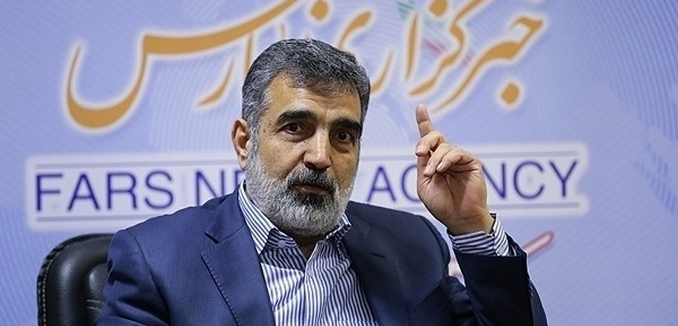On the occasion of its National Nuclear Day, Iran boasted that it could enrich uranium to 20% in just two days’ time, if the United States would withdraw from the deal, the Associated Press reported Monday. The threat is an indication that the 2015 nuclear deal left much of the Islamic Republic’s nuclear infrastructure intact.
The boast, which came from Atomic Energy Organization of Iran (AEOI) spokesman, Behrouz Kamalvandi, was consistent with other claims from Iranian officials. Iranian President Hassan Rouhani said that in the absence of a deal, the United States “will see its impact within a week or less than a week.”
The boasts that Iran would quickly return to an accelerated nuclear weapons program in the absence of the deal are consistent with claims made by other Iranian officials, and that the nuclear deal left much of Iran’s nuclear infrastructure untouched.
Last August, Ali Akbar Salehi, head of AEOI said that Iran could enrich uranium to 20% in five days. The Associated Press reported at the time that “uranium enriched to 20 percent and above can be used in nuclear bombs.”
A week before Salehi’s boast, Rouhani threatened that Iran could advance its nuclear program to a level more advanced than it was before nuclear negotiations began in 2013, “not within months and weeks, but in a matter of hours and days.”
Last week Reuel Marc Gerecht and Ray Takeyh, senior fellows at the Foundation for Defense of Democracies and the Council on Foreign Relations respectively, wrote in The Washington Post that Iran is exploiting the deal to modernize its nuclear infrastructure with advanced centrifuges in ways that would make detection of its nuclear weapons work much more challenging.
The deal satisfied two conditions that Iran needed to advance its nuclear weapons work: it lifted sanctions and it is also “permissive enough to allow the development of these machines.”
The nuclear deal, Gerecht and Takeyh wrote, gives Iran “at least eight years to fully develop a new generation of centrifuges,” to replace the thousands of first generation centrifuges it currently has installed.
Under Salehi’s guidance, Iran is seeking to develop its more advanced centrifuges which can be used to create cascades that can enrich uranium to weapons-grade and “can be easily concealed in a warehouse, making them extremely difficult to detect.”
The 2015 nuclear deal, like earlier nuclear deals Iran agreed to, will allow Iran to advance its nuclear weapons research.
Rouhani, who led Iran’s nuclear negotiators with the West from 2003 to 2005, boasted in 2006 that he used negotiations with the Europeans to complete Iran’s installation of equipment to convert yellowcake, a necessary step in the uranium enrichment process. He said that the negotiations created a “tame situation,” which allowed Iran to finish its work at that time.
During his first campaign for president, Rouhani similarly boasted that rather than suspending Iran’s nuclear program during his tenure as nuclear negotiator, “We were the ones to complete it! We completed the technology.”
[Photo: Fars News Agency ]




